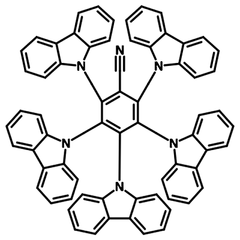Penta-carbazolylbenzonitrile (5CzBN)
CAS Number 1469700-24-0
Dopant Materials, High Purity Sublimed Materials, Semiconducting Molecules, TADF Materials
5CzBN, light-blue TADF fluorescence emitter
High-purity (>99.0%) and available online for priority dispatch
5CzBN, penta-carbazolylbenzonitrile, is sterically hindered due to the five bulky electron-donating carbazolyl groups on the benzene ring struggling for space. It is a light-blue TADF fluorescence emitter widely used for highly efficient TADF-OLED devices.
General Information
| CAS number | 1469700-24-0 |
|---|---|
| Full name | 2,3,4,5,6-penta(carbazol-9-yl)benzonitrile |
| Synonyms | 5CzCN, 2,3,4,5,6-penta(9H-carbazol-9-yl)benzonitrile |
| Chemical formula | C67H40N6 |
| Molecular weight | 929.1 g/mol |
| Absorption | λmax 325 nm, 348 nm and 420 nm in DCM |
| Fluorescence | λem 488 nm in toluene |
| HOMO/LUMO | HOMO = 5.55 eV, LUMO = 2.74 eV, T1 = 2.68 eV [1] |
| Classification / Family | Carbazole, Phthalonitrile, TADF materials, Blue dopant materials, Sublimed materials |
Product Details
| Purity | Unsublimed >98%; Sublimed >99.0% (1H NMR) |
|---|---|
| Melting point | Tg = 318 °C (lit.) |
| Appearance | Yellow powder/crystals |
*Sublimation is a technique used to obtain ultra pure-grade chemicals. For more details about sublimation, please refer to the Sublimed Materials.
Chemical Structure

Device Structure(s)
| Device structure | ITO/HATCN (5 nm)/NPB (30 nm)/TCTA (10 nm)/mCBP:5CzBN (20 wt%) (30 nm)/DpyPA:Liq (1:1, 30 nm)/LiF (0.5 nm)/Al (150 nm) [2] |
|---|---|
| Colour | Blue |
| Max. EQE | 16.7% |
| Max. Power Efficiency | 40.0 Im/W |
| Device structure | ITO (100 nm)/HATCN (10 nm)/TrisPCz (30 nm)/mCBP (10 nm)/15wt%-5CzBN:mCBP (30 nm)/T2T (10 nm)/BPyTP2 (40 nm)/LiF (0.8 nm)/Al (100 nm) [3] |
|---|---|
| Colour | Blue |
| Max. EQE | 18.0% |
| Max. Power Efficiency | 49.9 Im/W |
*For chemical structure information, please refer to the cited references.
MSDS Documentation
Pricing
| Grade | Order Code | Quantity | Price |
|---|---|---|---|
| Sublimed (>99.0% purity) | M2219A1 | 250 mg | £420 |
| Sublimed (>99.0% purity) | M2219A1 | 500 mg | £700 |
| Sublimed (>99.0% purity) | M2219A1 | 1 g | £1150 |
| Unsublimed (>98.0% purity) | M2219B1 | 250 mg | £260 |
| Unsublimed (>98.0% purity) | M2219B1 | 500 mg | £420 |
| Unsublimed (>98.0% purity) | M2219B1 | 1 g | £660 |
Literature and Reviews
- Recent progress of green thermally activated delayed fluorescent emitters, Y. Im et al., J. Info. Display, 18 (3), 101-117 (2017); DOI: 10.1080/15980316.2017.1333046.
- Sterically shielded blue thermally activated delayed fluorescence emitters with improved efficiency and stability, D. Zhang et al., Mater. Horiz., 3, 145-151 (2016); doi: 10.1039/C5MH00258C.
- Excited state engineering for efficient reverse intersystem crossing, H. Noda et al., Sci. Adv., 4:eaao6910 (2018); DOI: 10.1126/sciadv.aao6910.
- Evidence and mechanism of efficient thermally activated delayed fluorescence promoted by delocalized excited states, T. Hosokai et al., Sci. Adv., 3:e160328 (2017); DOI: 10.1126/sciadv.1603282.
- Modulation of Förster and Dexter Interactions in Single-Emissive-Layer All-Fluorescent WOLEDs for Improved Efficiency and Extended Lifetime, P. Wei et al., Adv. Funct. Mater., 2019; DOI: 10.1002/adfm.201907083.
- Highly efficient and stable blue thermally activated delayed fluorescence emitters, D. Zhang et al., SPIE (2016); DIO: 10.1117/2.1201611.006797.
- Critical role of intermediate electronic states for spin-flip processes in charge-transfer-type organic molecules with multiple donors and acceptors, H. Noda et al., Nat. Mater., 18(10), 1-7 (2019); DOI: 10.1038/s41563-019-0465-6.

 5CzBN MSDS sheet
5CzBN MSDS sheet